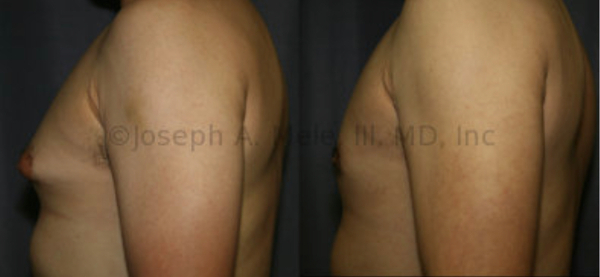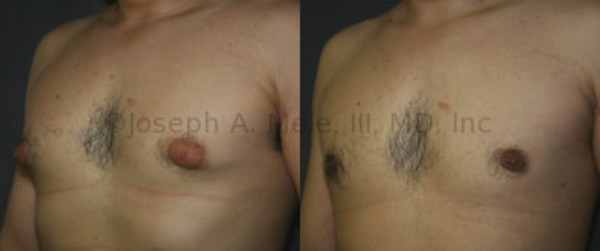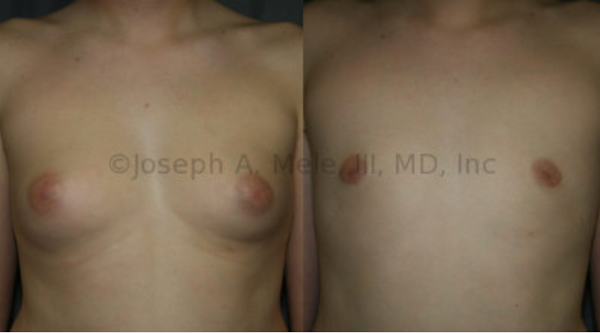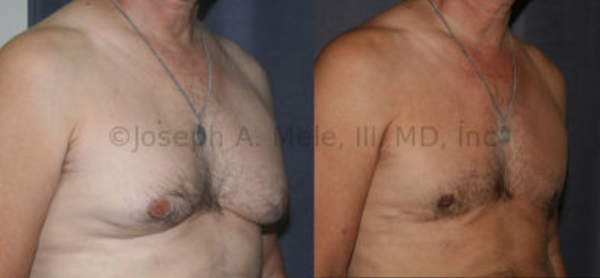
Gynecomastia is normal breast tissue and fat in the male chest, that is often disproportionate. When large enough, it causes a feminization of the chest, and in the case above, puffy nipples. Direct excision of the excess breast tissue creates a more masculine appearance, and less embarrassment at the beach.
More men are having Cosmetic Plastic Surgery. Since starting my practice in 1997, the number of cosmetic procedures performed among men has increased over 325%, according to the American Society for Aesthetic Plastic Surgery (ASAPS). Liposuction remains the number one requested procedure; however Male Breast Reduction, or Gynecomastia Reduction, has the fastest growth rate.
How Common Is Male Breast Reduction Surgery?
In 1997, according to the American Society of Plastic Surgeons (ASPS), around 20,000 men underwent Gynecomastia Reduction. Last year, over 30,000 men did the same, representing a 5 to 7% increase from the previous year’s data. The word is out. You don’t have to live with man boobs anymore.
What Is Gynecomastia?
Gynecomastia is the medical term for enlargement of the male breast. Enlargement can as small as a lump under the areola, to large enough to look like a well endowed female breast, and everything in between.
When Does Gynecomastia Arise And Will it Go Away?

Gynecomastia Reduction: In this case, direct excision of the glandular tissue from under the areola not only smooths the chest’s contour, but also reduces the apparent size of the areolae — the pigmented skin that surrounds the nipple. The darker color is simply a result of the same amount of pigment distributed over the new, significantly smaller, area.
Gynecomastia normally becomes a problem at puberty. It is estimated that two-thirds of men suffer from some degree of breast enlargement during adolescence, and that for half of them, it persists into adulthood. If you are a young man with a new lump in your breasts, it is a good idea to have it checked by your family doctor to be certain the tissue and your hormones are normal. The best early treatment for true Gynecomastia is usually observation, as half the cases with resolve on there own within two years of developing.
What Is Gynecomastia Made Of?
Just like in the female breast, there are two tissue types found in the enlarged male breast: glandular tissue (breast) and adipose (fat). The amount and location of these tissues determines how best to treat the gynecomastia. Glandular tissue is firm, tough and sometimes painful. Adipose is soft, weak and non-tender. Glandular tissue is most often found under the nipple and areola, with a tail extending to the side, while fatty tissue is more peripheral. Both are more likely to be found in the lower pole of the male chest. Too much of either can stretch the skin to the point that extra skin may also need to be removed.
How Is Gynecomastia Treated?

Gynecomastia Reduction: Sometimes the amount of breast tissue on the chest is enough to completely feminize the chest. Liposuction, combined with direct excision of the glandular components, restored the flat chest that this young man is expected to have. Again, the reduction in areolae is due to the skin’s elastic contraction after the breasts are unstuffed.
So how do I treat Gynecomastia? The answer depends on several factors and the best way to find out what can be done in your specific case is to schedule a personal consultation appointment with an experienced, Board Certified Plastic Surgeon in your area.
For adolescents, usually the best treatment is to wait a few years and see if it goes away. On the other hand, all new lumps should be checked by your primary medical doctor to be safe. If the area has persisted for several years, and is not resolving, Gynecomastia Reduction may be the best next step.
For adults, first you must be healthy. Male Breast Reduction is an elective procedure and needs to be held to a higher standard. If treatment is safe, there are the components to breast reduction that need to be evaluated and treated: the amount of gland, the amount of fat and the amount of skin.
Glandular tissue, true breast tissue, responds best to direct surgical excision. It is tough, so the cannulas used for Liposuction often just bounce off it. Fatty tissue, on the other hand, is soft and responds well to Liposuction. Both methods reduce the amount of “stuffing” in the chest, and allow the skin to shrink.

Gynecomastia Reduction: Sometimes the skin enveloping the breasts is redundant. This man has breast enlargement and sagging from his gynecomastia and loose skin. In this case, the breast tissue and the excess skin were removed through an incision that runs along the bottom of each breast. Without this, the skin would sag further over the inframammary fold from the loss of support caused by removing the chest’s stuffing, just like deflating a balloon causes the balloon to fall over.
In most cases, the skin and the areola will shrink proportionately, to reveal the contours of the pectorals major muscles. In cases of extreme gynecomastia, or after large weight loss, the skin may be loose, and direct excision of the excess skin may be necessary. This needs to be determined at an in-person consultation.
Gynecomastia Reduction Consultations
If you are suffering with embarrassing, or painful, male breasts, treatment is available. Call my San Francisco Bay Area office in Walnut Creek, CA at (925) 943-6353 today, and schedule your private, informative consultation appointment. More information is available on line through the links embedded in this article and on my San Francisco Breast web site’s Gynecomastia Page.
Previous Post Next Post